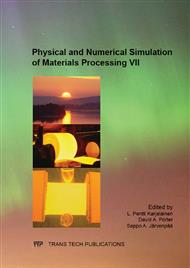p.95
p.104
p.110
p.116
p.122
p.128
p.134
p.140
p.146
Modelling of Strain Rate and Temperature Dependent Flow Stresses of Supercooled Austenite for AISI 4140
Abstract:
The numerical modelling of heat treatment has become an essential tool in understanding distortion potentials for case hardening. When looking at other surface hardening processes such as induction or laser hardening, high heating and cooling rates automatically lead to higher strain rates during the heat treatment cycle. So far, there have been almost no investigations on the strain rate as well as temperature dependency of the mechanical properties of supercooled austenite. In this paper, the typical induction and laser hardening steel AISI 4140 has been used in order to determine the influence of strain rate and temperature on the mechanical behaviour. The experiments are based on tensile tests, using a specifically designed thermo-mechanical simulator. The experimental results show that a positive strain rate sensitivity for strain rates up to 1 s-1 results. Especially in the temperature interval where austenite formation occurs during heating, the strain rate sensitive flow stress might lead to an alteration of the plastic strains in comparison to conventional heat treatments at low heating rates. The material model presented in this paper allows a good reproduction of the experimental data over a wide range of strain rates and temperatures.
Info:
Periodical:
Pages:
122-127
Citation:
Online since:
July 2013
Keywords:
Price:
Сopyright:
© 2013 Trans Tech Publications Ltd. All Rights Reserved
Share:
Citation:


